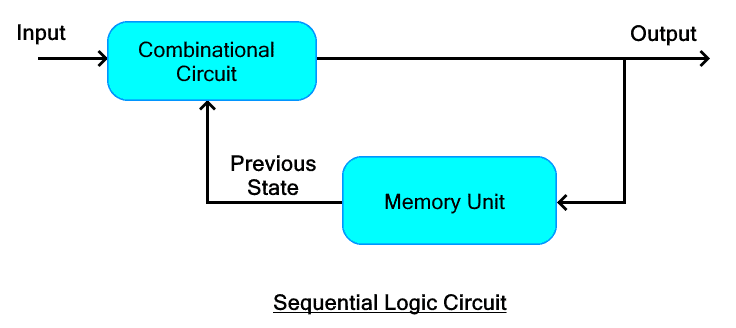Difference Between Digital Latch and Flip-Flop Circuits
What is the Main Difference Between Digital Latch and Flip Flop?
In digital electronics, there are two basic kinds of logic circuits; a combinational logic circuit and sequential logic circuit. The output of a combinational logic circuit depends only on the current input. While sequential logic circuit output depends on the current input as well as the previous output. Therefore, a memory unit is required to store the previous state.
There are two types of memory units; a latch and flip flop. Both of them are used in sequential logic circuits. The main difference between a latch and flip-flop is that a latch is level-triggered while a flip-flop is edge-triggered. This is the only difference that we generally remember and usually use to degrade latches. However, there are several other differences that really show the importance of the latch.
Related Post: Difference Between Combinational and Sequential Logic Circuits
Before going into the list of differences between latch and flip-flop, let’s discuss their basics first.
Sequential Logic Circuit
A sequential logic circuit is a type of logic circuit whose output depends on the current input and previous output. It is made of a combinational logic circuit and a memory unit. The memory unit is used to store the output state. There are two types of memory units i.e. latch and flip-flop. Both of them are capable of storing one bit of data.
Latch
A Digital Latch is a digital circuit used for storing a bit of data. It is a bi-stable multivibrator having two stable states i.e. low and high. It has a control input that is used to trigger or activate the latch known as the enable pin.
A latch is a level-sensitive device and it is triggered by the level of the control signal. An active-low latch is activated by the low enable input while an active-high latch is activated by high enable input.
When a latch is enabled it processes the input signal and updates its output state accordingly. It can process the input multiple times when it is enabled. and The output may change during that period due to the changes in input called glitches. There is a time delay required for the output to settle called set-up time.
However, latches have fewer number of gates allowing them to have a high speed with low design cost and manufacturing. It also has comparatively lower power consumption and takes less area.
Related Posts:
- Difference between Photodiode and Photoresistor (LDR)
- Difference Between Photodiode and Phototransistor
Flip Flop
A Digital Flip-flop is also a digital circuit that stores one bit of binary data. It is edge sensitive i.e. it is triggered by the edge of the control signal called clock signal.
A flip flop is made from a pair of latches in a master-slave configuration. The master latch and the slave latch is triggered by different levels of the clock signal. Therefore it processes the input data during the clock edge i.e. rising edge (low to high) or falling edge (high to low).
A flip-flop only processes the input data when there is a clock edge. It remains inactive throughout the high or low-level state of the clock signal. Therefore flip-flops are synchronous devices.
The edge-triggered allows it to have a glitch-free operation. The downside though is that flip-flop is made of a pair of latches. Therefore it has more logic gates than latches and subsequently has a slower operating speed due to added gate delay.
Related Posts:
Key Differences between latch and flip Flop
The following table shows the comparisons between digital flip-flops and latches.
| Latch | Flip Flop |
| A latch is a memory unit that is level sensitive. It is triggered by the level of the enable pin. | A is a memory unit that is edge sensitive. It is triggered by the edge of the clock signal. |
| It is level triggered i.e. it can only change state when there is a low or high level signal at the enable pin | The flip-flop is edge-triggered. It can only change state when there is a rising or falling edge of the clock signal. |
| It does not have a clock signal. | It has a clock signal. |
| A latch is an asynchronous device | A flip-flop is a synchronous device. |
| It is made from a pair of logic gates depending on design. | It is made from a pair of latches. Thus having twice as many gates as a latch. |
| It has a faster operating speed. | It has a slower operating speed due to the gate delay. |
| It consumes less power | It consumes relatively twice as much power. |
| It takes up less space. | It takes up more space as it is made of twice as many gates. |
| It is prone to glitches called metastability | Flip Flop is free of glitches. |
| It cannot be used as a register. | It can be used as a register. |
Related Posts:
To conclude this article, we can say that latches are not as bad as we generally thought of them. Sure they have glitches which can be eliminated when used with proper design. Overall they are cost-effective and less power-consuming, combined with their fast speed making them much more suitable for certain applications. However, flip-flops find many uses throughout digital circuits.
Related posts compare and contrast various electrical and electronic components and devices.
- Difference Between Fast Recovery Diode and Step Recovery Diode
- Difference Between Schottky Diode and Fast Recovery Diode
- Difference Between Phototransistor and Photoresistor (LDR)
- Difference Between JFET and MOSFET
- Difference Between BJT and FET Transistors
- Difference Between Diode and SCR (Thyristor)
- Difference Between Transistor & Thyristor (SCR)
- Difference Between Diode and Transistor
- Difference Between NPN and PNP Transistor
- Difference Between Inverting and Non-Inverting Amplifier
- Difference Between Amplifier and Operational Amplifier
- Difference Between Voltage Source and Current Source
- Difference between Voltage Source Inverter & Current Source Inverter
- Difference between Inverter & UPS – Uninterruptible Power Supply
- Difference Between Encoder and Decoder
- Difference Between Microprocessor and Microcontroller
- Difference Between 8085 & 8086 Microprocessor – Comparison
- Difference Between RAM and ROM – Comparison
- Difference Between CPU and GPU – Comparison
- Difference between Active and Passive Components
- Difference Between Multiplexer (MUX) & Demultiplexer (DEMUX)
- Main Difference Between Sensor and Actuator
- Main Difference between Sensor and Transducer
- Difference between Zener Diode and Avalanche Diode










